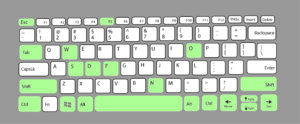Keyboard accessibility is an important aspect of accessible design. It allows users to navigate through web pages and experience content through assistive elements. An example of keyboard navigation involves key commands. These commands act as navigation guides for the user that provide quick and efficient interactions. There are two links that discuss the different key command interactions between Windows and Mac posted below.

Example of Key Commands
Shown are examples of simple key commands that assist keyboard users in simple navigation. The examples range from adjusting page sizes, navigating around a web page, opening and closing active windows, turning on narrator settings, and utilizing the on-screen keyboard.
Tab: navigates direction
Shift+Tab: Previous Action
Spacebar: Move page down
Alt+D: Select address bar
Ctrl+E: Select search bar
Ctrl+N: New window
Shift 5 Times: Turns on sticky keys
Windows logo key+ Ctrl+ N: Open narrator settings
Windows logo key + Ctrl + S: Windows speech recognition
Windows logo key + Ctrl + O: Turn on the on-screen keyboard